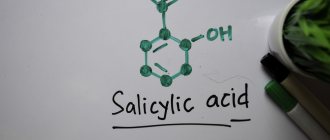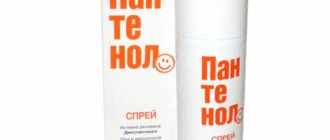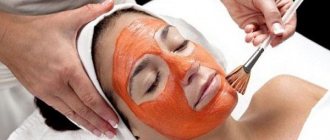Progress in cosmetology does not stop for a minute. More and more effective drugs are appearing on the shelves of stores and pharmacies. However, affordable, proven, familiar means are still popular. Salicylic acid is no exception. It is still at the top of the list among cosmetologists and dermatologists, thanks to its positive effects on the skin.
Properties
Unlike other acids used in cosmetology, salicylic acid is characterized by efficiency and speed of action. Her main abilities include:
- anti-inflammatory, antiseptic effect due to the destruction of bacteria and microorganisms;
- decreased secretion of sweat and sebaceous glands;
- keratolytic (exfoliating) effect by softening, drying and cleansing the skin of dead particles;
- accelerating skin regeneration by increasing blood flow to the damaged area and stimulating cell division;
- improving collagen production (protecting it from destruction).
Is there any service that will help evaluate the effectiveness of the composition?
Eat! It's called What Is In My Jar, literally "what's in my jar." Enter the name of your product into the search and get a mini-analysis of it. The service will evaluate the effectiveness of the product and tell you about the risk of developing skin irritation. The product is divided into groups of ingredients with a note about their concentration. The design is such that even without advanced knowledge of English you can figure out whether you bought a good cream or not. The only negative: the service is familiar with foreign care products, but not with Russian ones. Not all cosmetics can be sorted out based on their composition.
What is it used for and can salicylic acid help with acne?
Salicylic acid is a low molecular weight, fat-soluble acid. It acts on the surface of the skin, epidermis, dermis, and inside the pores. It is used in various fields of medicine to treat many skin diseases (seborrhea, dermatitis, psoriasis, lichen, eczema, keratosis, etc.).
Salicylic acid and preparations based on it are also successfully used in cosmetology. Thanks to its strong disinfecting and exfoliating effect, it fights skin defects.
Dark spots
This is an area of darker colored skin. It may be the result of genetic characteristics, vitamin deficiency, stress, etc. The effect is achieved through exfoliation and lightening of the skin.
Before and after using salicylic acid
Ingrown hairs
Most often they appear after hair removal procedures (depilation, epilation). Changing the direction of hair growth leads to its ingrowth under the skin and the formation of foci of inflammation. Salicylic acid in liquid form gently releases hair and fights inflammation.
Warts
Salicylic acid is effective due to its softening effect. And the antiseptic effect prevents the appearance of new formations.
Before and after - removal of a wart on the nose
Dandruff
A common cause of dandruff is fungus. Salicylic acid is aimed at combating it. By cleansing the skin, eliminating inflammatory processes and normalizing the functioning of the sebaceous glands, in addition to getting rid of dandruff, volume, shine and accelerated hair growth are achieved.
Black dots
Mechanical treatment of the skin is not always effective, while using salicylic acid on the face cleanses the pores on its own.
Acne
The cause of the defect is increased secretion of sebum, its thickening and accumulation in the pores, followed by inflammation. Salicylic acid for acne is one of the most effective remedies. It is used as an independent product or component of tonics, washes, and lotions. The use of such products will eliminate inflammation, reduce pain, dry out the problem area, and normalize the functioning of the sebaceous glands, which will reduce the likelihood of new rashes.
Before and after - acne disappearance
Indications and contraindications
As you already understand, products with salicylic acid are effective for problem skin, but acne is not the only reason why you should purchase cosmetics with this component. What other indications are there?
- oily skin;
- inflammation;
- burns;
- black dots;
- post-acne;
- warts;
- dandruff.
The component also has contraindications:
- hypersensitivity;
- children under 3 years of age;
- excessive dry skin;
- pregnancy and breastfeeding;
- renal failure.
What cosmetic products use salicylic acid?
Due to its properties, salicylic acid is a common component of many skin care products. Salicylic acid can be found in products such as:
- shower gel
- foam
- scrub
- peeling
- tonic
- lotion
- serum
- mask
- cream
- shampoo
- antiperspirant
- local preparations (ointments, creams)
- napkins
- patch
Is it true that there are dangerous ingredients in cosmetics?
It's a difficult question. On the one hand, yes, some ingredients in cosmetics are potentially dangerous. You've probably read about the dangers of parabens or formaldehyde. They are generally considered to be powerful allergens. But the truth is that the concentration that they have in the composition of the skincare product is too small to provoke an allergy and generally cause any harm.
The products you see on store shelves have passed safety checks and you can buy them without fear. There are no dangerous ingredients in cosmetics. And if it does, it means that you bought the product from an unverified seller or the product turned out to be defective with an unsafe composition. Perhaps you are simply intimidated by those who have not read new research and expert reviews. And there they write: if you use parabens correctly, there will be no harm.
Is it better to use liquid or other form for the face?
On pharmacy shelves you can find salicylic acid in liquid form (solutions with different concentrations), powder and in the form of ointments.
1-2% solutions of salicylic acid are often used for acne and other inflammations. The composition of such liquids, in addition to the main component, includes 70% alcohol.
It is not recommended to use 3-5-10% solutions of salicylic acid for the face at home, as improper use can lead to burns.
The powder can be used to prepare solutions yourself. However, you need to strictly observe the proportions so as not to make a mistake with the dosage and not burn the skin during use.
Ointments are also available in different concentrations (2-3-5-10%). Main components: acid and petroleum jelly. It is recommended to apply 2-3% of the product to the inflamed areas for several days.
What ingredients are responsible for the appearance, texture, smell?
Surfactants or surfactants
These substances are responsible for cleaning power and foam formation. They can clean skin, hair, teeth and even dishes! But they are all different: for skin you need softer surfactants, for household utensils - harsher ones. They simultaneously attract and repel water, so they can wash away dirt and grease from any surface. They can be found in all cleansers, as well as shampoos.
| Sodium Lauryl Sulfate | Castile soap |
| Coco betaine | Acyl glycinates |
| Sulfosuccinate | Alkyl acyl isethionates |
Emulsifiers
Emulsifiers help different ingredients mix together. For example, the white and yolk of one egg are normally two immiscible liquids. But if you mix them, you get just an emulsion. To simplify, cream is a mixture of oil and water, where the predominance is in the direction of oils. And lotion is the same, but with an advantage in favor of water.
| Glyceryl stearate | PEG‑8 |
| Lecithin | Cetearyl Alcohol |
| Sorbitan stearate | Ceteareth-25 |
| Glyceryl oleate | Stearic Acid |
| Laureth‑3 |
This is an incomplete list, but we have listed the most popular emulsifiers in skincare products. Now scary Latin names with numbers won't scare you - they're just thickeners in your products.
Alcohols
Fatty alcohols in cosmetics make the texture of the product softer and are stabilizers in all products. Thanks to them, the cream can be used for three years, and it is safe. They should not be confused with regular alcohol. Ethyl alcohol is not added to cosmetics; it can only be found in hand sanitizers.
| Parabens | Sorbic Acid |
| benzylalcohol | Gluconolactone |
| Dehydroacetic acid | Sodium Benzoate |
Emollients
Their main task is to soften the skin. Particularly important for people with atopic dermatitis, eczema and other types of skin irritation and inflammation.
| Natural oils | Squalane |
| Silicones | Mineral oil |
| Cetyl palmitate | Sucrose Cocoate |
| Isolanolin |
Acidity stabilizers
The chemical composition of the product is maintained so that all ingredients work effectively and provide visible results. Cosmetics diplomats prevent different chemicals from conflicting with each other.
| Triethanolamine | Magnesium hydroxide |
| Citric acid | Sodium hydroxide |
| Sodium gluconate |
Perfume composition
Responsible for smell. The product must smell good so that you want to buy it and apply it to your skin and hair. To do this, natural or synthetic flavors are added to the composition.
| Fragrance | Cinnamal |
| Parfum/Perfume/Aroma | Limonene |
| Linalool | Essential Oils |
| Citronellol |
How to properly use salicylic acid products
In order for the product to bring only benefits, you need to know and adhere to the rules of use. The main ones:
- before first use, apply to a small area to identify an allergic reaction;
- choose the concentration depending on your skin type (oily 2%, normal 1%, dry - 0.5% or refrain from using);
- Do not use salicylic acid in liquid form or in the form of ointments with a high concentration of the active substance;
- single inflammations should be treated pointwise;
- Avoid applying to areas with moles, birthmarks, and open wounds;
- When using, do not rub the product into the skin to prevent burns;
- It is advisable not to combine with other means;
- take breaks between courses;
- use the drug in the evening or 1.5-2 hours before going outside to avoid the appearance of age spots from the influence of the sun, wind, and low temperatures.
What in the composition gives the effect?
Moisturizing group
Moisturizers, or scientifically called humectants, help attract moisture into the skin from the external environment. These are magnets for H2O molecules. And due to the fact that they cover the surface layer of the skin with a thin film, water will not disappear from its deep layers. If you choose a moisturizer, look for these substances in cosmetics:
| Algae Extract | Hydrolyzed Collagen |
| Hyaluronic Acid | Glycerin |
| Aloe vera | Propylene Glycol |
| Butylene Glycol | Sorbitol |
| Ceramides | Honey |
Acid group
These include alpha and beta hydroxy acids - AHA and BHA. The most popular acids that are usually included in cosmetics are:
| Glycolic Acid | Citric Acid |
| Lactic Acid | Salicylic Acid |
These are chemical exfoliants - substances that gently exfoliate the skin and renew it. In general, the skin itself is capable of doing this, but in some cases it cannot cope with exfoliation and needs help. This happens if you have acne - the pores are clogged with dead particles and sebum. To do this, it is better to use products with BHA acids - they mainly contain salicylic acid, other beta hydroxy acids are rarely found in formulations.
Cleansing with acids is also useful for hyperpigmentation - to get rid of post-acne, you need to renew the skin. You just need to use AHA acids. They are of plant or animal origin. For example, glycolic, milk, almond.









